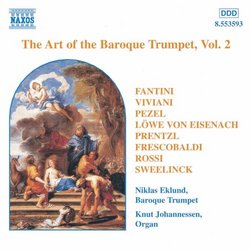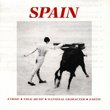| All Artists: Niklas Eklund Title: Art of the Baroque Trumpet, Vol 2 Members Wishing: 0 Total Copies: 0 Label: Naxos Release Date: 1/1/1998 Genres: Special Interest, Classical Styles: Chamber Music, Forms & Genres, Fantasies, Historical Periods, Baroque (c.1600-1750), Instruments, Brass Number of Discs: 1 SwapaCD Credits: 1 UPC: 730099459327 |
Search - Niklas Eklund :: Art of the Baroque Trumpet, Vol 2
 | Niklas Eklund Art of the Baroque Trumpet, Vol 2 Genres: Special Interest, Classical
|
Larger Image |
CD DetailsSimilar CDs
|
CD ReviewsExcellent program of neglected works Patrick Randall | 05/05/2008 (5 out of 5 stars) "Reviewers of other installments of the 5-disc "Art of the Baroque Trumpet" series have deplored the repertoire included on this album, citing taste and monotony of style. The first charge I dismiss, and as for the second charge, I disagree. The 17th-century works selected are foremost chamber works, and Eklund achieves superb balance with the organ, bassoon, and especially with Marc Ullrich, second trumpet on several of the tracks. His playing here is extremely tasteful as well as full of careful attention to style. That said, it is never dull. Most of the pieces have received notable performances by modern-instrument specialists, but several, like the Prentzl Sonata and the Pezel Sonata No. 75-- a highlight of the album-- have not, to my knowledge, been previously recorded. I believe the only other recording of the Eisenach capriccios was done by baroque trumpet pioneer Adolf Scherbaum, and was not reissued from LP. As for the better known pieces, they hold up well against any other recording. The Viviani makes an excellent counterpart to the recordings by Maurice Andre and Hakan Hardenberger." Eklund does it again! kenneth Philip Jones | Tˇrshavn Faroe Islands | 09/29/2000 (4 out of 5 stars) "The playing on this CD is again head and shoulders above any recording made on a natural trumpet. The playing especially in the upper register is so clean that one can only know it is a natural trumpet because of the "lip trills." I now own all four volumes of "The Art of Baroque Trumpet" and the only reason I give this volume four stars instead of five is because of my personal taste in repertoire which for me gives volumes 1,3&4 the higher rating." "Have Horn Will Travel" Giordano Bruno | Wherever I am, I am. | 09/28/2009 (5 out of 5 stars) "Wind players (piffari, Stadtpfeiffern) were a peripatetic bunch in the 16th and 17th Century, often chasing the crops of compositions from court to court. Organs, on the other hand, have a decided tendency to stay put. Since 'pitch' was as local as sundial-time in the era, problems of compatibility were common. Organ pitch in Venice, for instance, was about A466, while in Florence it was a step and in Rome a step and a half lower. When a trumpeter and an organist came together for music-making, often someone had to transpose. These problems of pitch are informatively discussed in the notes of "The Art of the baroque Trumpet, Vol. 2", which features composition for organ solo, organ and trumpet, organ and two trumpets, and organ with trumpet and bassoon. If you're interested in such esoteric matters, you have merely to purchase the CD and read for yourself.
The tracks on this CD by Frescobaldi, Sweelinck, and Michelangelo Rossi are complex fantasies for organ alone. The organ played here is a mean-tone instrument with air supplied by two bellows, pitched at A460, with two manuals, 21 stops, and 1113 pipes. It resides in the north transept of the Haga Church in Göteborg, Sweden, where it has been since ... 1991! It was built to order by John Brombaugh of Eugene, Oregon, modeled after seventeenth century German organs. A similar Brombaugh organ is in captivity in a church in Berkeley, California. The "Toccata settima" of M. Rossi is a magnificent piece of music, worth the price of this bargain CD ten times all by itself. It's also a stunning example of the implications of quarter-comma meantone tuning for consonance, affective dissonance, expressive chromaticism, and sequential modulation. Even listeners whose ears have been co-opted by piano scales all their lives should be able to hear the difference. I can't think of better evidence for the necessity of performing keyboard music written FOR meantone instruments On meantone instruments. It's simply more exciting. Trumpeter Niklas Eklund plays a trumpet with finger holes; his thoughts about the tuning of natural and 'baroque' trumpets are also expressed in the CD notes. On several tracks, he is joined by trumpeter Marc Ullrich and/or bassoonist Mats Klingfors; the two trumpet anonymous Sinfonia is perhaps the most flamboyant display of 'chops' on the recording. All of the pieces on ABT v2 are from the 17th Century, the century during which the trumpet established itself as a consort and concerto-worthy instrument rather than a mere fanfare extravagance for princes. Even as late as Gabrieli and Monteverdi, trumpets were expected only to play the limited natural notes of their harmonic progression, even in their 'clarino' upper range. In the 16th C, the trombone (clearly evolved from the slide trumpet of Medieval times) and the cornetto had teamed up to dominate the winds. (Don't confuse the cornetto with the later cornet!) The leading exponent of treating the trumpet as a 'complete' instrument was Girolamo Fantini (1600-c1675), the most famous trumpeter of Italy, represented by two sonatas on this CD. In general, this music represents a repertoire in transition and an instrument in even more marked transition to keep up with the music. There are five volumes in this set of performances. I've already reviewed Vol 1, which features trumpet concertos and sonatas by Telemann, Handel, Purcell and others, played by Eklund and the Drottningholm Baroque Ensemble, on authentic instruments of the baroque. Volume 3, which I'll review next, features Eklund's trumpet matched gloriously with the soprano voice of Susanne Rydén." |

 Track Listings (14) - Disc #1
Track Listings (14) - Disc #1

